A language is a system of communication. Spoken languages are composed of sounds, syllables, and words that convey an agreed upon meaning. But languages can also be made from visual or physical symbols. In the Star Wars: Rebels episode Wolves and a Door, Sabine Wren reads the language of hands in a piece of art that adorns the outside of Lothal’s ancient Jedi temple. Through her interpretation, Ezra is able to gain access to the temple. Skytalkers Podcast released a fantastic episode on this topic (please see link below), which discussed hands not just in Rebels but also in the full body of Star Wars, and here I’m expanding upon one aspect which they briefly touched upon in that episode: mudras or hand gestures in yoga.
The word mudra comes from Sanskrit and it means seal, mark, or gesture, and are used in numerous spiritual and artistic contexts such as Indian classical dance, hatha yoga, Buddhist iconography, and esoteric Hindu and Buddhist rituals. Sacred texts discuss the way hands and fingers are traditionally positioned in each context, and as these gestures remain consistent, viewers are able to read meaning in the hands much as Sabine did.
The Father: Abhaya
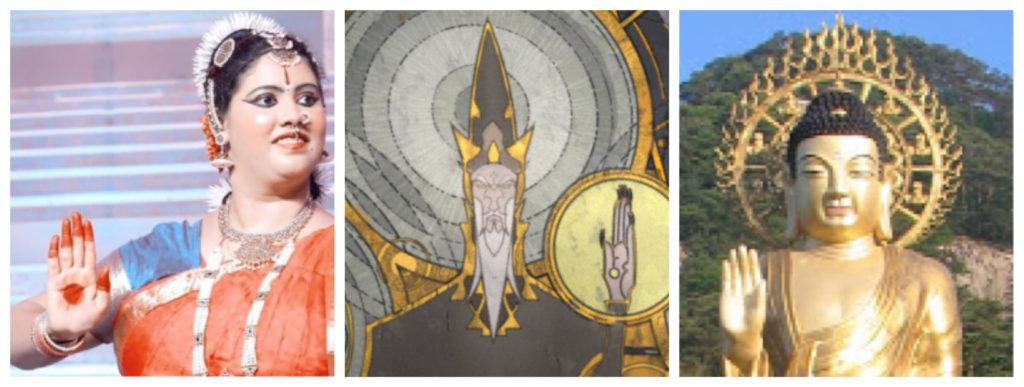
While many of the hand postures are shared between the traditions, their meanings may be interrelated but not identical. For instance, in Rebels, the Father makes a hand gesture showing an open palm facing the viewer with fingers pressed together, pointing up. In Buddhist iconography, this gesture is called abhaya, or “without fear”. Buddhas are shown making this sign in order to reassure the viewer that their purpose is peaceful and benign.
However, in Indian classical dance, the same mudra is called pataka or flag. Classical Sanskrit texts describe how this gesture is to be used in a dance context.It can be used to convey a number of meanings including blessing, silence, equanimity, an ideal king, or pushing open a door.
Considering what we know about the Father from Rebels and The Clone Wars Mortis arc, some of the implications of his open palmed hand signal may be significant. In the most literal sense, the Father’s hand does represent pushing a door open once it has been unlocked. Here, the door is the portal opened by the wolves running in a circle.
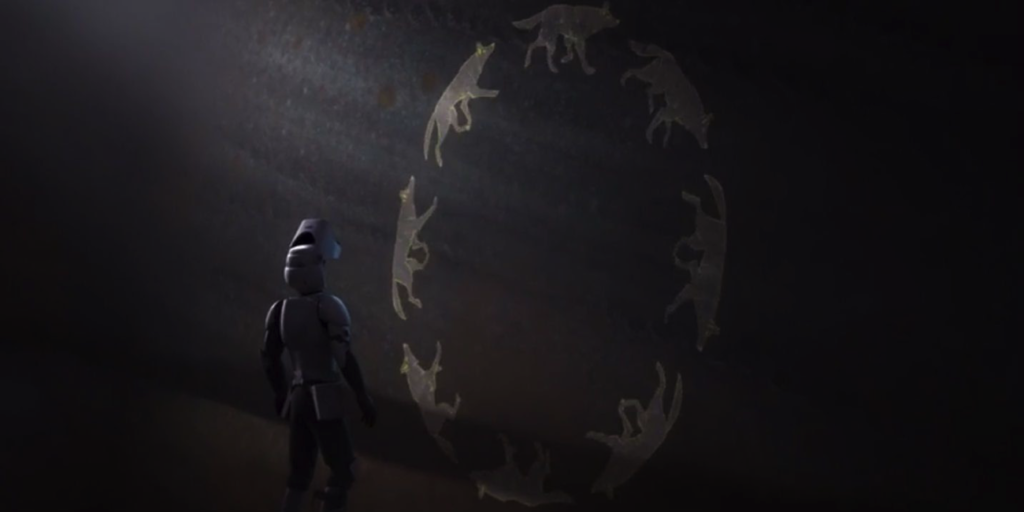
In a way, the art of the Mortis gods’ hands represent a three step process, if the hands are read left to right: First, unlock the door; then, find silence and equanimity inside; and, finally, close and seal the door.
Ezra approaches the frieze of the Mortis trinity with apprehension, but the Father’s gesture is reassuring. There’s truly nothing to fear inside the temple. Or rather, much like a Force cave, the only fear is that which you bring with you. Therefore, the Father’s mudra could be read as an instruction to enter the temple with peace and equanimity.
The Father is a cosmic leader of sorts, so perhaps it is fitting that his hand gesture connotes ideal kingship whether or not he is one in truth.
The Son: Mushti
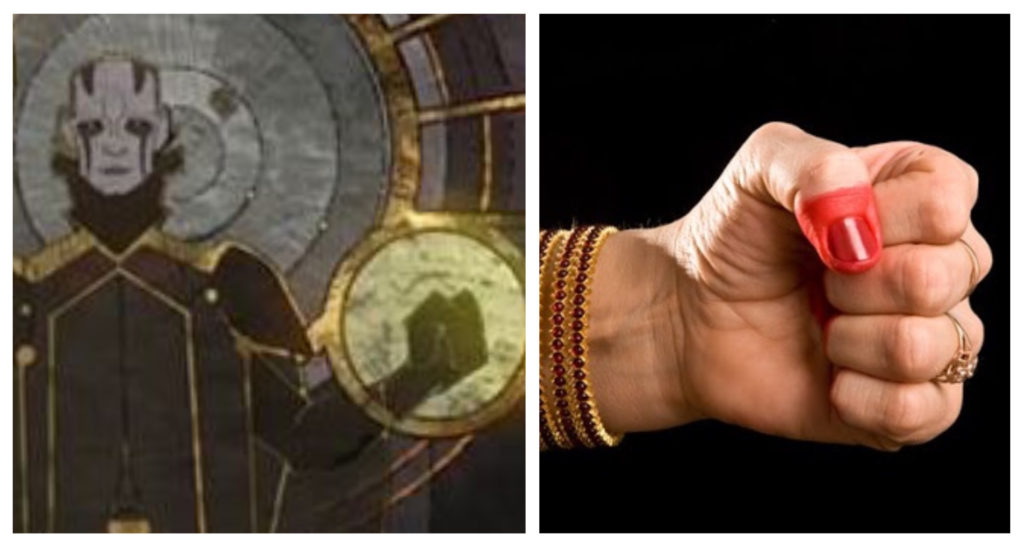
The Son’s gesture also has an equivalent in Indian dance. He makes the sign of mushti, or a fist. Mushti, the fist mudra, is used in dance to communicate combativeness, grasping an object, and steadfastness.
Again, these traditional meanings for the fist are appropriate for the Son. Not only is the Son aggressive and combative, he is also unwavering in holding onto his goals. His hand literally conveys the idea of a grasping, which in a Buddhist spiritual context is the foundation of human suffering.
As I mentioned above, one of the meanings of mudra is a seal. In yoga, mudras can be performed with different parts of the body, not just with the hands. One kind of mudra involves tightening the diaphragms to seal in or contain the energies that flow within the body. In this sense, the Son’s fist does represent a seal. Here the seal is the shutting of the portal into the Jedi temple such that the energy and power contained within it does not escape.
The Daughter: Tirodhana
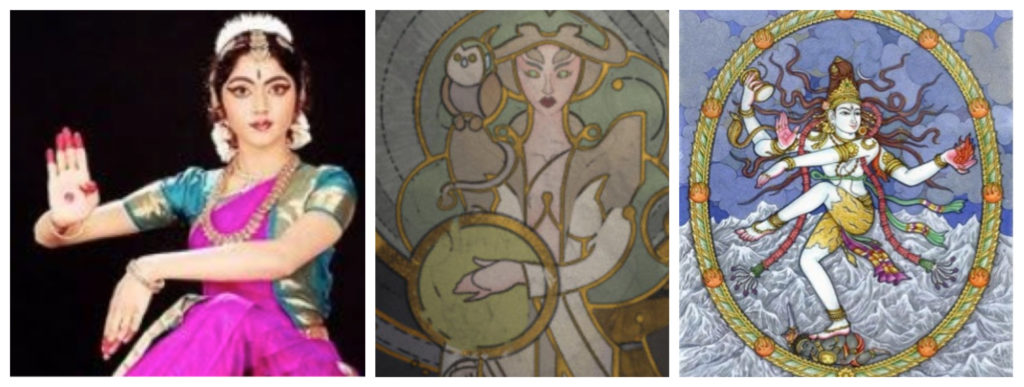
Finally, the hand gesture made by the Daughter shows the back of her hand to the viewer. The closest equivalent of this hand gesture is one made by Shiva in the posture of Nataraja, Lord of the Dance. Here his left hand points downward displaying the back of the hand to the viewer. This gesture is called tirodhana, meaning occlusion, concealment or secrecy.
Most mudras show the hand either from the side or with the palm facing the viewer, but she shows us the back of the hand rather than the palm. She is closed rather than open. The tirodhana gesture of concealment or inscrutability signifies the hiddenness of the temple’s secrets. Just as the Jedi temple is closed from the outside, so that the back of her hand is like the door being closed to the world. The Daughter might be willing to show what is hidden inside the temple, but only to the worthy.
Mudras can also be facial expressions and head positions. The Daughter turns her face away from the viewer, hiding anything she has to communicate. However, she does seem to point with her face to the Father. This encourages the viewer to follow the direction of reading the mural from left to right, as the Father’s hand moves to point to the Son after Ezra has activated the opening sequence.In so many ways, Star Wars has drawn from the traditions of Asia, such as Hinduism and Buddhism. Whether or not the meanings I have derived from reading the language of the hands of the Mortis gods was intentional, I think it is not far-fetched to assume that the concepts shown in the Rebels episodes were inspired by these traditions. By returning to the historical source material that it originally drew from, we can learn to read new, deeper layers of meaning in the art and stories of Star Wars.
Sources for further reading:
Skytalker’s Podcast episode “The Hands Are a Language”
Wikipedia article on mudras. Includes basics of use in artistic and religious traditions.
Classical South Asian dance tradition (Bharatnatyam) definition for pataka hand gesture.
Classical South Asian dance tradition (Kathak) guide to hand gestures and their names.
Arts directory description of the use of mudras as a way of communicating in dance.
Article on the fundamentals of artistic traditions in South Asia, including dance and painting.
Tricycle Magazine article “Mudra: What do Buddhist Hand Gestures Mean?”
Manuscript with depictions of esoteric Japanese Buddhist mudras.
List of the many kinds of mudras as used in yoga practice (particularly hatha yoga).
Indian newspaper Tribune India article on what mudras do for the user. View into Indic ideas of the physical and spiritual body.

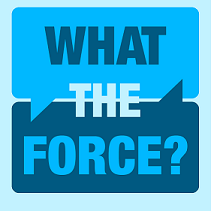
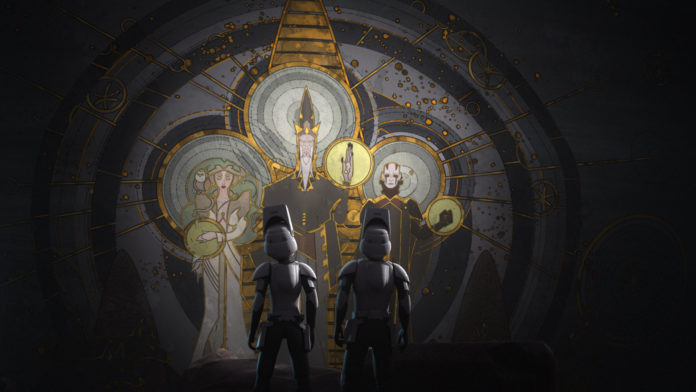
Awesome & informative article Susan!! 🙂 It’s always so nice for me to see my religion & culture somewhat explored/represented in fiction (+ how we talk about myth & fiction) because it’s pretty rare (at least in Western media). Really appreciate all the sources (I will be checking a lot of them out) and the connection between the Mortis gods was something I hadn’t thought about before but makes a lot of sense!